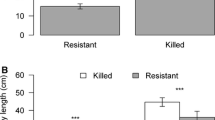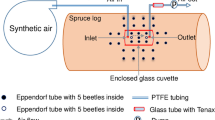Abstract
The secondary chemistry of host plants can have cascading impacts on the establishment of new insect herbivore populations, their long-term population dynamics, and their invasion potential in novel habitats. Mountain pine beetle, Dendroctonus ponderosae Hopkins (Coleoptera: Curculionidae) has recently expanded its range into forests of jack pine, Pinus banksiana Lamb., in western Canada. We investigated whether variations in jack pine monoterpenes affect beetle pheromone production, as the primary components of the beetle’s aggregation pheromone, (−)-trans-verbenol and anti-aggregation pheromone (−)-verbenone, are biosynthesized from the host monoterpene α-pinene. Jack pine bolts were collected from five Canadian provinces east of the beetle’s current range, live D. ponderosae were introduced into them, and their monoterpene compositions were characterized. Production of (−)-trans-verbenol and (−)-verbenone emitted by beetles was measured to determine whether pheromone production varies with monoterpene composition of jack pines. Depending on particular ratios of major monoterpenes in host phloem, jack pine could be classified into three monoterpenoid groups characterized by high amounts of (+)-α-pinene, 3-carene, or a more moderate blend of monoterpenes, and beetle pheromone production varied among these groups. Specifically, beetles reared in trees characterized by high (+)-α-pinene produced the most (−)-trans-verbenol and (−)-verbenone, while beetles in trees characterized by high 3-carene produced the least. Our results indicate that pheromone production by D. ponderosae will remain a significant aspect and important predictor of its survival and persistence in the boreal forest.





Similar content being viewed by others
References
Berryman AA, Dennis B, Raffa KF, Stenseth NC (1985) Evolution of optimal group attack, with particular reference to bark beetles (Coleoptera, Scolytidae). Ecology 66:898–903
Bleiker KP, Six DL (2007) Dietary benefits of fungal associates to an eruptive herbivore: potential implications of multiple associates on host population dynamics. Environ Entomol 36:1384–1396
Blomquist GJ, Figueroa-Teran R, Aw M, Song M, Gorzalski A, Abbott NL, Chang E, Tittiger C (2010) Pheromone production in bark beetles. Insect Biochem Mol Biol 40:699–712
Borden JH, Pureswaran DS, Lafontaine JP (2008) Synergistic blends of monoterpenes for aggregation pheromones of the mountain pine beetle (Coleoptera: Curculionidae). J Econ Entomol 101:1266–1275
Chénier JVR, Philogène BJR (1989) Field responses of certain forest coleoptera to conifer monoterpenes and ethanol. J Chem Ecol 15:1729–1745
Clark EL, Pitt C, Carroll AL, Lindgren BS, Huber DPW (2014) Comparison of lodgepole and jack pine resin chemistry: implications for range expansion by the mountain pine beetle, Dendroctonus ponderosae (Coleoptera: Curculionidae). Peer J 2:e240–e240
Erbilgin N, Colgan J (2012) Differential effects of plant ontogeny and damage type on phloem and foliage monoterpenes in jack pine (Pinus banksiana). Tree Physiol 32:946–957
Erbilgin N, Raffa KF (2000a) Effects of host tree species on attractiveness of tunneling pine engravers, Ips pini, to conspecifics and insect predators. J Chem Ecol 26:823–840
Erbilgin N, Raffa KF (2000b) Opposing effects of host monoterpenes on responses by two sympatric species of bark beetles to their aggregation pheromones. J Chem Ecol 26:2527–2548
Erbilgin N, Christiansen E, Krokene P, Zeneli G, Gershenzon G (2006) Exogenous application of methyl jasmonate elicits defenses in Norway spruce (Picea abies) and reduces host colonization by the bark beetle Ips typographus. Oecologia 148:426–436
Erbilgin N, Ma C, Whitehouse C, Shan B, Najar A, Evenden M (2014) Chemical similarity between historical and novel host plants promotes range and host expansion of the mountain pine beetle in a naive host ecosystem. New Phytol 201:940–950
Franceschi VR, Krokene P, Christiansen E, Krekling T (2005) Anatomical and chemical defenses of conifer bark against bark beetles and other pests. New Phytol 167:353–375
Goslee SC, Urban DL (2007) The ecodist package for dissimilarity-based analysis of ecological data. J Stat Softw 22:1–19
Gries G, Leufven A, Lafontaine JP, Pierce HD, Borden JH, Vanderwel D, Oehlschlager AC (1990) New metabolites of alpha-pinene produced by the mountain pine-beetle, Dendroctonus ponderosae (Coleoptera: Scolytidae). Insect Biochem 20:365–371
Huber DPW, Borden JH (2001) Protection of lodgepole pines from mass attack by mountain pine beetle, Dendroctonus ponderosae, with nonhost angiosperm volatiles and verbenone. Entomol Exp Appl 99:131–141
Jermy T (1984) Evolution of insect host plant relationships. Am Nat 124:609–630
Keeling CI, Bohlmann J (2006) Genes, enzymes and chemicals of terpenoid diversity in the constitutive and induced defence of conifers against insects and pathogens. New Phytol 170:657–675
Keeling CI, Chiu CC, Aw T, Li M, Henderson H, Tittiger C et al (2013) Frontalin pheromone biosynthesis in the mountain pine beetle, Dendroctonus ponderosae, and the role of isoprenyl diphosphate synthesis. Proc Natl Acad Sci USA 110:18838–18843
Lusebrink I, Evenden ML, Blanchet FG, Cooke JEK, Erbilgin N (2011) Effect of water stress and fungal inoculation on monoterpene emission from an historical and a new pine host of the mountain pine beetle. J Chem Ecol 37:1013–1026
Miller DR, Borden JH (2000) Dose-dependent and species-specific responses of pine bark beetles (Coleoptera: Scolytidae) to monoterpenes in association with pheromones. Can Entomol 132:183–195
Miller DR, Borden JH (2003) Responses of lps pini (Say), Pityogenes knechteli Swaine and associated beetles (Coleoptera) to host monoterpenes in stands of lodgepole pine. J Entomol Sci 38:602–611
Moore B, Andrew RL, Kulheim C, Foley WJ (2014) Explaining intraspecific diversity in plant secondary metabolites in an ecological context. New Phytol 201:733–750
Oksanen J, Blanchet FJ, Kindt R, Legendre P, Minchin PR, O'Hara RB, Simpson GL, Solymos P, Stevens MHH, Wagner H (2013) Vegan: Community ecology package. R package version 2.0-10
Phillips MA, Croteau RB (1999) Resin-based defenses in conifers. Trends Plant Sci 4:184–190
Pierce HD, Conn JE, Oehlschlager AC, Borden JH (1987) Monoterpene metabolism in female mountain pine beetles, Dendroctonus ponderosae Hopkins, attacking ponderosa pine. J Chem Ecol 13:1455–1480
Pitman GB, Vité JP (1969) Aggregation behaviour of Dendroctonus ponderosae (Coleoptera: Scolytidae) in response to chemical messengers. Can Entomol 101:143–149
Pitman GB, Vité JP, Kinzer GW, Fentiman AF (1968) Bark beetle attractants – trans-verbenol isolated from Dendroctonus. Nature 218:168–169
Pureswaran DS, Borden JH (2003) Is bigger better? Size and pheromone production in the mountain pine beetle, Dendroctonus ponderosae Hopkins (Coleoptera: Scolytidae). J Insect Behav 16:765–782
Pureswaran DS, Gries R, Borden JH, Pierce HD (2000) Dynamics of pheromone production and communication in the mountain pine beetle, Dendroctonus ponderosae Hopkins, and the pine engraver, Ips pini (Sag) (Coleoptera: Scolytidae). Chemoecol 10:153–168
Raffa KF, Berryman AA (1983a) The role of host plant-resistance in the colonization behaviour and ecology of bark beetles (Coleoptera: Scolytidae). Ecol Monogr 53:27–49
Raffa KF, Berryman AA (1983b) Physiological-aspects of lodgepole pine wound responses to a fungal symbiont of the mountain pine-beetle, Dendroctonus ponderosae (Coleoptera: Scolytidae). Can Entomol 115:723–734
Raffa KF, Aukema BH, Erbilgin N, Klepzig KD, Wallin KF (2005) Interactions among conifer terpenoids and bark beetles across multiple levels of scale: an attempt to understand links between population patterns and physiological processes. Recent Adv Phytochem 39:79–118
Reid ML, Purcell JRC (2011) Condition-dependent tolerance of monoterpenes in an insect herbivore. Arthropod Plant Interact 5:331–337
Safranyik L, Carroll AL, Regniere J, Langor DW, Riel WG, Shore TL, Peter B, Cooke BJ, Nealis VG, Taylor SW (2010) Potential for range expansion of mountain pine beetle into the boreal forest of North America. Can Entomol 142:415–442
Seybold SJ, Huber DPW, Lee JC, Graves AD, Bohlmann J (2006) Pine monoterpenes and pine bark beetles: a marriage of convenience for defense and chemical communication. Phytochem Rev 5:143–178
Taft S, Najar A, Godbout J, Bousquet J, Erbilgin N (2015) Variation in foliar monoterpenes across the range of jack pine reveal three widespread chemotypes: implications to host expansion of invasive mountain pine beetle. Front Plant Sci 6: 342. doi:10.3389/fpls.2015.00342
Therneau TM, Atkinson B, De'ath G (2013) Mvpart: multivariate partitioning. R Package Version 1:6–1
Wheeler RE (2010) multResp() lmPerm version 1.1-2. The R project for statistical computing
Zhao T, Borg-Karlson A-K, Erbilgin N, Krokene P (2011) Host resistance elicited by exogenous application of methyl jasmonate alters the aggregation pheromone of spruce bark beetle, Ips typographus. Oecologia 167:691–699
Acknowledgments
Funding for this project was provided by Alberta Innovates–New Faculty Award and Natural Sciences and Engineering Research Council of Canada–Discovery to NE. We also thank Canada Research Chairs Program (http://www.chairs-chaires.gc.ca/home-accueil-eng.aspx) for their support NE. We extend thanks to the following people for extensive help with field work, bolt collection, and the logistical challenges of shipping bolts across Canada: Dr. Jon Sweeney and Cory Hughes of Canadian Forest Service, Atlantic Forestry Centre; Dr. Deepa Pureswaran and Stéphane Bourassa of Canadian Forest Service, Laurentian Forestry Centre; Dr. Taylor Scarr and Dan Rowlinson of the Ontario Ministry of Natural Resources; and Fiona Ross of Manitoba Conservation and Water Stewardship. Dale Depottie Weyerhaeuser provided live beetles for research. Jennifer Klutsch (U of A) provided insight and feedback throughout this project. We also thank two anonymous reviewers for constructive and useful comments.
Author information
Authors and Affiliations
Corresponding author
Rights and permissions
About this article
Cite this article
Taft, S., Najar, A. & Erbilgin, N. Pheromone Production by an Invasive Bark Beetle Varies with Monoterpene Composition of its Naïve Host. J Chem Ecol 41, 540–549 (2015). https://doi.org/10.1007/s10886-015-0590-x
Received:
Revised:
Accepted:
Published:
Issue Date:
DOI: https://doi.org/10.1007/s10886-015-0590-x




